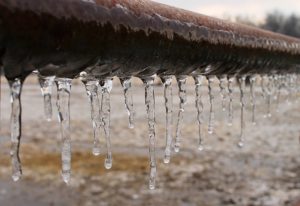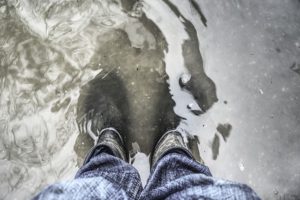
Mold can appear in any season, but in seasons where the moisture levels rise there is a higher chance of mold thriving within your home. Whenever mold is a possibility you can always ask yourself one question: What causes mold? It doesn’t take much to grow a large colony of mold microbes, often undetectable until it’s a much bigger issue. There are a few things mold requires to thrive: space to spread, food to eat, and warm moisture.
Whenever mold is a possibility you can always ask yourself one question: What causes mold? It doesn't take much to grow a large colony of mold microbes, often undetectable until it's a much bigger issue. Share on XIn the winter moisture levels are high inside homes. A combination of people spending more time inside, tracking in moisture on boots, and other factors such as excessive condensation on windows all contribute to the perfect mold environment! Here are some great things to look out for in the wintertime that may be contributing to mold growth in your home:
 CONDENSATION CAUSES MOLD
CONDENSATION CAUSES MOLDFor many people, their daily routine involved wiping the excess moisture off their windows in the morning. Why do windows collect so much moisture? This excess moisture occurs when the warm air inside the house meets against the window with the cold air outside of the house creating condensation that then drips down onto your window sill. Left unchecked this water sits in the sills, fostering serious mold growth and that black grime many of us dread cleaning.
Aluminum windows are commonly found in homes and tend to be more prone to condensation than their more modern vinyl counterparts. If upgrading the windows in your home is not a realistic solution keeping any mold growth in check is very easy! Just remember to:
Don’t forget about your bathroom! If your bathroom doesn’t have an extractor fan chances are those lovely, hot showers are creating serious condensation on bathroom windows, mirrors, and even in your cabinets. Be sure to always have at least one window open during your shower or bath, wipe up any excess moisture on surfaces afterward, and leave windows/doors open to encourage airflow through the room. Drying out as much moisture as possible, combined with regular cleaning measures, will keep your bathroom mold-free!
 FLOODING CAUSES MOLD
FLOODING CAUSES MOLDIt is not uncommon for the effects of a serious snowstorm to be felt weeks after the initial fall. The surplus of water combined with cold temperatures can create chaos for homeowners. Many people with below-ground basement suites experience flooding as the snow melts and abnormally large volumes of water look for places to go.
Going toe-to-toe with mother nature rarely ends up as a win; however, there are some things you can do to help divert water away from your home:
Depending on where you live your plumbing may or may not be rated to withstand freezing temperatures. The snowstorm experienced only a few weeks ago throughout Texas was an unprecedented cold front that had catastrophic effects on citizens’ plumbing. When your plumbing is being serviced by an above-ground pipe, exposed to harsh cold this can cause parts of your plumbing lines to contract and potentially fracture, resulting in a burst pipe and flooding.
To prevent plumbing-related issues associated with extreme cold snaps it is recommended to leave the faucet dripping. This constant flow of water can prevent freezing in the line. If you notice a leak or any suspicious water coming from any area of your plumbing, use the water shut-off valve to terminate the water supply to your home and contact a professional to assess any potential issues. Smaller leaks on a frozen line are often a precursor for larger issues.
If you notice a leak or any suspicious water coming from any area of your plumbing, use the water shut-off valve to terminate the water supply to your home and contact a professional to assess any potential issues. Smaller leaks on a… Share on XThese are two very serious sources of water damage, which is how a large number of mold issues begin. It takes as little as 24-48 of unattended water damage to allow mold spores to germinate and spread. Combine this with the fact that one of their main food sources is wood, water damage in your gold can escalate into a serious mold exposure situation almost instantly!
 WET CLOTHING CAUSES MOLD
WET CLOTHING CAUSES MOLDWhether it’s snow or mud, kids or dogs, the wintertime is the season of wet outerwear. Once you come in from the cold it’s extremely easy to kick off those wet boots and leave them to drip into the floor. Whether you have hardwood, laminate, or carpet, water can easily work its way into all the nooks of your flooring without being noticed. This unnoticed moisture can result in undetected mold growth in your subfloor and undersides of carpets, all while exposing your entire household to toxic mold spores.
We are happy to report that this is an easy fix! For wet boots and shoes, we recommend utilizing a washable, absorbent rubber-bottom mat in doorways. This mat will easily catch the outdoor moisture, wick it away keeping your floors safe. Once it has become saturated or soiled, throw it into the washing machine to soak and wash with some vinegar, killing any present nasty microbes.
By monitoring these factors you can potentially stop a serious mold issue from happening! As always, we recommend working natural preventative measures into your cleaning routine. After remediating any visible mold with hydrogen peroxide and vinegar, use Homebiotic Probiotic Spray to create a probiotic barrier over surfaces to keep your home balanced and protected. Keep surfaces clean with without chemicals using the Homebiotic Surface Cleaner.

Gillian is a former nurse and joined the Homebiotic team as a researcher & science writer. She loves traveling the world and currently lives in Colombia.